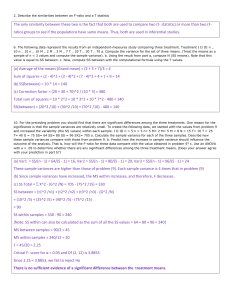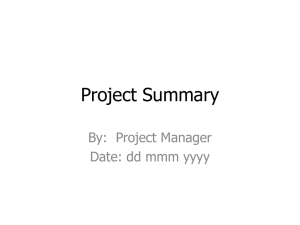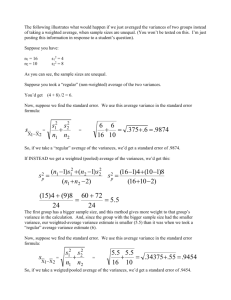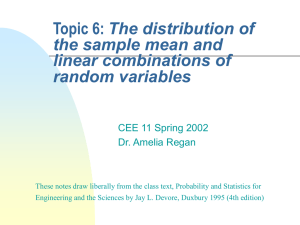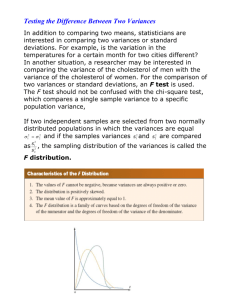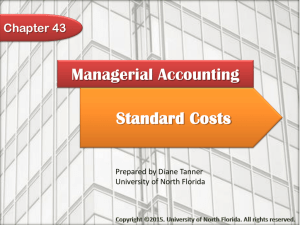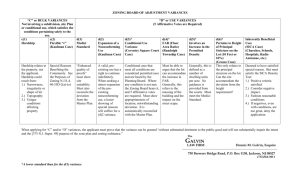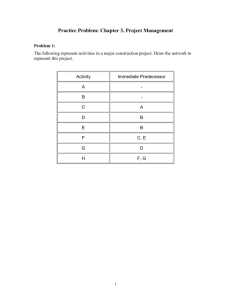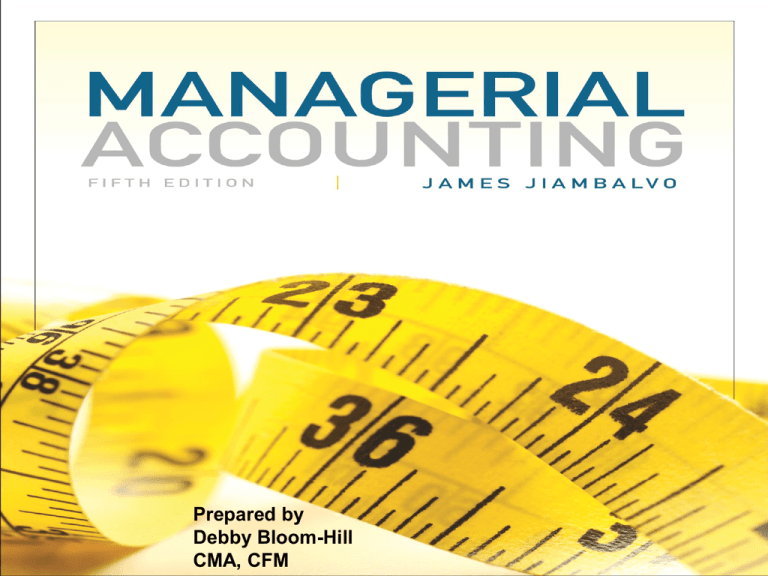
Prepared by
Debby Bloom-Hill
CMA, CFM
CHAPTER 11
Standard Costs
and
Variance Analysis
Slide 11-2
Standard Costs and Budgets
Standard cost
Cost that management believes should
be incurred to produce a product or
service under anticipated conditions
Standard costs can be used by
manufacturing and service companies
A tool manufacturer may set a standard
cost for producing a hammer
A bank may set a standard cost for
processing a check
Slide 11-3
Learning objective 1: Explain how standard
costs are developed
Standard Costs and Budgets
The term standard cost often refers to
the cost of a single unit
The term budgeted cost often refers to
the cost, at standard, of the total
number of budgeted units
The cost information contained in
budgets must be consistent with
standard costs
Slide 11-4
Learning objective 1: Explain how standard
costs are developed
Standard Costs and Budgets
If materials budget indicates purchases of 5,000
pounds, standard cost is $25,000 (5,000 pounds
* $5 standard cost per pound)
If labor budget is prepared for 1,000 units
produced, 3,000 labor hours are needed at a
standard cost of $30,000 (3,000 hours * $10)
Slide 11-5
Learning objective 1: Explain how standard
costs are developed
Starbucks
Slide 11-6
Learning objective 1: Explain how standard
costs are developed
Development of Standard Costs
Standard costs for material, labor and
overhead are developed in a variety of
ways
Standard quantity and price for
material may be specified:
In engineering plans that provide a list
of material
In recipes or formulas
By time and motion studies
In price lists provided by suppliers
Slide 11-7
Learning objective 1: Explain how standard
costs are developed
Development of Standard Costs
Standard quantity and rate for direct
labor may be specified:
By time and motion studies
Through analysis of past data
By management expectations of rates to
be paid
In contracts that set labor rates
Standard costs for overhead involves
procedures similar to those used to
develop predetermined overhead rates
Slide 11-8
Learning objective 1: Explain how standard
costs are developed
Ideal versus Attainable Standards
In developing standard costs, some
managers emphasize ideal standards
while others use attainable standards
Ideal standards assumes that no
obstacles to the production process will
be encountered
Managers who support ideal standards
believe they motivate employees to
strive for the best possible control over
production costs
Slide 11-9
Learning objective 1: Explain how standard
costs are developed
Ideal versus Attainable Standards
Attainable standards are standard
costs that take into account the
possibility that a variety of
circumstances may lead to costs that
are greater than ideal
If equipment breakdowns and defects
are a fact of life, it makes sense to plan
for their associated costs
Most managers support the use of
attainable standards
Slide 11-10
Learning objective 1: Explain how standard
costs are developed
What is the primary benefit of a standard
costing system?
a. It records costs at what should have been
incurred
b. It allows a comparison of differences
between actual and standard costs
c. It is easy to implement
d. It is inexpensive and easy to use
Answer: b
It allows a comparison of differences between
actual and standard costs
Slide 11-11
Learning objective 1: Explain how standard
costs are developed
Standard Costing
Slide 11-12
Learning objective 1: Explain how standard
costs are developed
A General Approach to Variance
Analysis
Companies that use standard costing
can analyze the difference between a
standard and an actual cost
Called a standard cost variance
Determines whether operations are
being performed efficiently
The analysis is called variance analysis
It generally involves breaking down the
differences between standard and
actual cost into two components
Slide 11-13
Learning objective 1: Explain how standard
costs are developed
A General Approach to Variance
Analysis
Direct material variances
Material price variance
Material quantity variance
Direct labor variances
Labor rate variance
Labor efficiency variance
Manufacturing overhead variances
Overhead volume variance
Controllable overhead variance
Slide 11-14
Learning objective 1: Explain how standard
costs are developed
Material Variances
Material price variance
Difference between the actual price per
unit of material (AP) and the standard
price per unit of material (SP) times the
actual quantity of material purchased (AQ)
Material quantity variance
Difference between the actual quantity of
material used (AQ) and the standard
quantity of material allowed for the
number of units produced (SQ) times the
standard price of material (SP)
Slide 11-15
Learning objective 2: Calculate and interpret
variances for direct material
Material Variances
Standard for 1 unit: 400 lbs @ $10 per lb
Materials purchased: 200,000 lbs @ $9.90 per lb
Materials used: 181,000 lbs to produce 450 units
Slide 11-16
Learning objective 2: Calculate and
interpret variances for direct material
You Get What You Measure!
Slide 11-17
Learning objective 2: Calculate and
interpret variances for direct material
Data for chips used in the production of computers
Standard: 3 chips per computer @ $6.50 per chip
Quantity purchased: 200 chips for total of $1,350
Quantity used: 123 chips for production of 40 units
Calculate the material price variance
Actual Cost of
Material Purchased
AQp X AP
200 X $6.75
$1,350
Actual Quantity of Material
Purchased at Standard Price
AQp X SP
200 X $6.50
$1,300
$1,350 - $1,300 = $50
Unfavorable price variance
Slide 11-18
Learning objective 2: Calculate and
interpret variances for direct material
Data for chips used in the production of computers
Standard: 3 chips per computer @ $6.50 per chip
Quantity purchased: 200 chips for $1,350 total
Quantity used: 123 chips for production of 40 units
Calculate the material quantity variance:
Actual Quantity of Material
Used at Standard Price
AQu X SP
123 X $6.50
$800
Standard Cost
SQ X SP
(40 X 3) X $6.50
$780
$800 - $780 = $20
Unfavorable quantity variance
Slide 11-19
Learning objective 2: Calculate and
interpret variances for direct material
Direct Labor Variances
Labor Rate Variance
Difference between actual wage rate
(AR) and standard wage rate (SR) times
the actual number of labor hours
worked (AH)
Labor Efficiency Variance
Difference between actual number of
hours worked (AH) and the standard
labor hours allowed for the number of
units produced (SH) times the standard
labor wage rate (SR)
Slide 11-20
Learning objective 3: Calculate and interpret
variances for direct labor
Direct Labor Variances
Standard for 1 unit: 4 hours @ $15 per hour
Actual labor: 1,700 hours @ $15.50 per hour to
produce 450 units
Slide 11-21
Learning objective 3: Calculate and
interpret variances for direct labor
Data for labor used in the production of sneakers
Standard: .25 hours per sneaker at $12.00 per hour
Actual quantity produced: 24,500 sneakers
Quantity used: 6,000 hours, total cost $69,000
Calculate the labor rate variance:
Actual Labor
AH X AR
6,000 X $11.50
$69,000
Actual Quantity of Labor at
Standard Rate
AH X SR
6,000 X $12.00
$72,000
$69,000 - $72,000 = ($3,000)
Favorable rate variance
Slide 11-22
Learning objective 3: Calculate and
interpret variances for direct labor
Data for labor used in the production of sneakers
Standard: .25 hours per sneaker at $12.00 per hour
Actual quantity produced: 24,500 sneakers
Quantity used: 6,000 hours, total cost $69,000
Calculate the labor efficiency variance:
Actual Quantity of Labor at
Standard Rate
AH X SR
6,000 X 12
$72,000
Standard Labor Cost
SH X SP
(24,500 X .25) X $12.00
$73,500
$72,000 - $73,500 = ($1,500)
Favorable efficiency variance
Slide 11-23
Learning objective 3: Calculate and
interpret variances for direct labor
Overhead Variances
Controllable overhead variance
Difference between the actual amount of
overhead and amount of overhead that
would be included in a flexible budget for
the actual level of production
Overhead volume variance
Difference between the amount of
overhead included in the flexible budget
and the amount of overhead applied to
production using the standard overhead
rate
Slide 11-24
Learning objective 4: Calculate and interpret variances
for manufacturing overhead
Overhead Variances
Standard for 1 unit: $50 overhead applied
Actual overhead: $23,000 to produce 450 units
Flexible budget overhead: $15,000 fixed + $20
per unit produced
Slide 11-25
Learning objective 3: Calculate and
interpret variances for direct labor
Interpreting Overhead Volume
Variance
Volume variances do not signal that
overhead costs are in or out of control
A volume variance signals that the
quantity of production was greater or
less than anticipated
The usefulness of the volume variance
is limited
It signals only that more or fewer units
have been produced than planned when
the standard overhead rate was set
Slide 11-26
Learning objective 5: Calculate the financial impact of
operating at more or less than planned capacity
Standard Cost Variance Formulas
Slide 11-27
Learning objective 5: Calculate the financial impact of operating at
more or less than planned capacity
Standard Cost Variance Formulas
Slide 11-28
Learning objective 5: Calculate the financial impact of operating at
more or less than planned capacity
A favorable labor efficiency variance means:
a. Labor rates were higher than called for by
standards
b. Inexperienced labor was used, causing the rate
to be lower than standard
c. More labor was used than called for by
standards
d. Less labor was used than called for by
standards
Answer: d
Less labor was used than called for by standards
Slide 11-29
Learning objective 5: Calculate the financial impact of
operating at more or less than planned capacity
What does an unfavorable overhead volume
variance mean?
a. Overhead costs are out of control
b. Overhead costs are in control
c. Production was greater than anticipated
d. Production was less than anticipated
Answer: d
Production was less than anticipated
Slide 11-30
Learning objective 5: Calculate the financial impact of
operating at more or less than planned capacity
Investigation of Standard Cost
Variances
Standard cost variances do not provide
definitive evidence that costs are out of
control and managers are not
performing effectively
They should be viewed as an indicator
of potential problem areas
The only way to determine whether
costs are being effectively controlled is
to investigate the facts behind the
variances
Slide 11-31
Learning objective 5: Calculate the financial impact of
operating at more or less than planned capacity
Standard Cost Variances
Slide 11-32
Learning objective 5: Calculate the financial impact of
operating at more or less than planned capacity
Management by Exception
Investigation of standard cost
variances is a costly activity
A management by exception approach
is to investigate only those variances
that are considered exceptional
Must determine criteria to measure
what is considered exceptional
Absolute dollar value of the variance
The variance as a percent of actual or
standard cost
Slide 11-33
Learning objective 6: Discuss how the management-by-exception approach is
applied to the investigation of standard cost variances
“Favorable” Variances May Be
Unfavorable
The fact that a variance is favorable
does not mean that is should not be
investigated
A favorable variance may be indicative
of poor management decisions
A poor decision regarding the quality
of raw materials might result in an
unfavorable variance in material
quantity
Slide 11-34
Learning objective 7: Explain why a favorable variance may be unfavorable, how process
improvements may lead to unfavorable variances, and why evaluation in terms of variances may
lead to overproduction
Can Process Improvements Lead
to “Unfavorable” Variances?
A firm may have an unfavorable
variance because it engaged in process
improvements
They can lead to greater efficiency
which results in actual labor hours
being less than standard labor hours
Firms should stimulate greater demand
to take advantage of the greater
production capabilities
Slide 11-35
Learning objective 7: Explain why a favorable variance may be unfavorable,
how process improvements may lead to unfavorable variances, and why
evaluation in terms of variances may lead to overproduction
Evaluation in Terms of Variances
Can Lead to Excess Production
When bottlenecks exist, the department
in front of the bottleneck should not
produce more than the bottlenecked
department can handle
If it does it will create excess work-inprocess inventory and result in a
negative impact on shareholder value
Slide 11-36
Learning objective 7: Explain why a favorable variance may be unfavorable,
how process improvements may lead to unfavorable variances, and why
evaluation in terms of variances may lead to overproduction
Responsibility Accounting and
Variances
The central idea of responsibility
accounting is that managers should be
held responsible for only the costs they
can control
Additionally, managers and workers
should only be held responsible for
variances they can control
Slide 11-37
Learning objective 7: Explain why a favorable variance may be unfavorable,
how process improvements may lead to unfavorable variances, and why
evaluation in terms of variances may lead to overproduction
Quality
Slide 11-38
Learning objective 7: Explain why a favorable variance may be unfavorable,
how process improvements may lead to unfavorable variances, and why
evaluation in terms of variances may lead to overproduction
Copyright
© 2010 John Wiley & Sons, Inc. All rights reserved.
Reproduction or translation of this work beyond that
permitted in Section 117 of the 1976 United States
Copyright Act without the express written permission of
the copyright owner is unlawful. Request for further
information should be addressed to the Permissions
Department, John Wiley & Sons, Inc. The purchaser
may make back-up copies for his/her own use only and
not for distribution or resale. The Publisher assumes no
responsibility for errors, omissions, or damages,
caused by the use of these programs or from the use of
the information contained herein.
Slide 11-39

